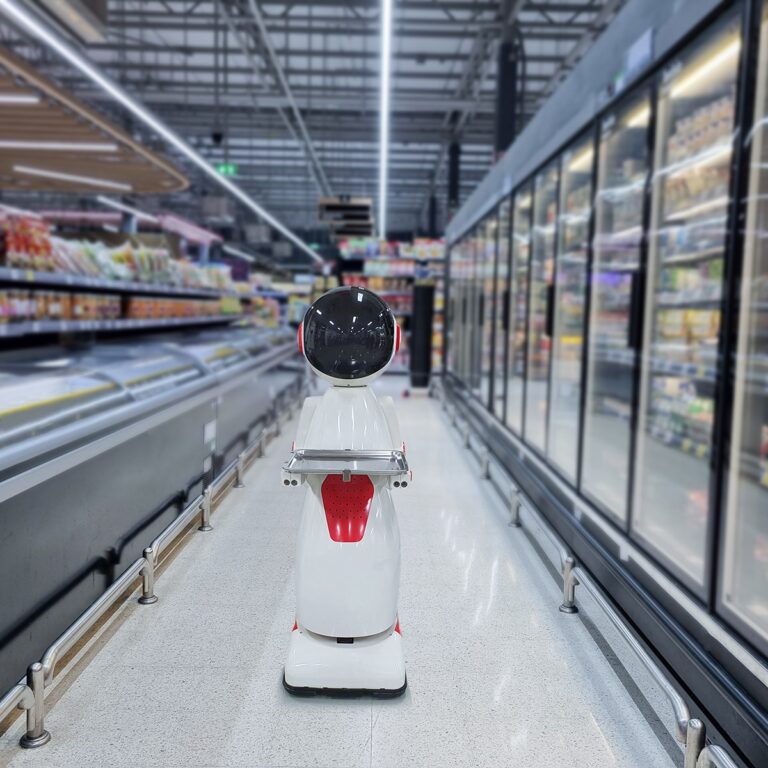AI is rapidly transforming the retail landscape, infiltrating everything from customer interaction to inventory management, and even those suspiciously empty aisles in your local grocery store. Let’s dive into how these digital masterminds are not just cutting costs but also pushing the limits of human interaction—if you can call it that.
1. Personalized Customer Experience
Picture this: a department store, both online and offline, using AI to sift through your order history and browsing habits as if it’s a detective compiling your case file. They’ll bombard you with marketing messages so tailored that they might as well call you by your social security number. Meanwhile, unsuspecting customers are treated to AI chatbots that sound like they’ve just taken a crash course in human conversation. “Care to discuss the existential meaning of your new coat, based on where you plan to wear it?” What a delightful twist!
2. Improved Cross-Selling Opportunities
As supply chain disruptions keep grocery stores reeling—thanks to crop failures, trucker strikes, and, let’s face it, the unpredictability of human nature—retailers are trying to appeal to your inner bargain hunter. Grocery stores are now aligning their inventory plans with demand forecasting like it’s some kind of high-stakes poker game. Will you be seeking late-night snacks or fresh ingredients for an impromptu dinner party? Only the supply chain gods know.
3. Automated Inventory Management
Remember the last time you wandered through a grocery store only to find the dairy section resembling a dairy graveyard? A small grocery chain has embraced AI to figure out the perfect moment to rotate those sad, wilted dairy products—much like a sad magician pulling a rabbit out of a hat. Meanwhile, a bustling European supermarket is using AI to constantly replenish stock, proving that even the most dedicated of shoppers can return to discover a fresh supply of midnight cheeses.
4. Demand Forecasting
Retailers can now harness AI’s all-seeing eye, cleverly analyzing data sets to predict exactly how many jars of peanut butter will be consumed in your state. Who knew that weather patterns and income levels could be so intimately met with the concept of snacks? One pharmacy even employed AI to forecast vaccine demand like it was charting the stock market, proving that desperation can indeed be a great motivator.
5. Frictionless Shopping
Gone are the days of awkwardly fumbling for cash while a line of people glares daggers at you. Some retailers have unleashed AI to eliminate traditional checkout lanes, allowing you to stealthily grab items and exit as if off the set of an espionage film. The cashiers? Just a mere figment of our past, while an AI swiftly scans and charges for goods with barcodes that cleverly decided to stay invisible. Call it a shopping heist—minus the criminal charges.
6. Optimized Pricing
What if I told you that AI can analyze your local grocery store’s prices and decide just how much you’re willing to pay before you even know it? Retailers are using this data cruncher to figure out the balance between affordability and total wallet-draining. Set prices too high, and boom—customers go flocking to the competition like moths to a flame. Set them too low? Well, congratulations, you’ve now given away your profits and devalued your products. It’s a real nail-biter.
7. Dynamic Merchandising
Imagine walking into a store where AI zips around recommending complementary products while you ponder which shade of lipstick best complements your insecurities. Retailers leverage this tech to boost sales and whip consumers into a frenzy over matching items. It’s almost poetic—except instead of Shakespeare, you’ve got a code that decides how to sell you more by knowing precisely what you didn’t know you needed. And yes, they’re constantly adjusting promotions, making it akin to a never-ending game of whack-a-mole.
8. In-Store Robots
Meet the latest employee of the month—a robot that doesn’t need breaks and has an excellent sense of direction. These robots, armed with cameras and sensors, are here to monitor your every move in the store, determining which products seem as popular as a cold cup of coffee. They can even send targeted promotions to your device while you’re standing right next to the item you just disregarded. Talk about a personal shopper with no sense of boundaries!
9. Smart Stores
Your local intelligent store is employing AI like this season’s must-have accessory. These smart wonders combine cameras and sensors to decode buyer behavior, suggesting that perhaps the ubiquitous “mystery meat” isn’t worth lingering over. If you think the suspense of your grocery list is thrilling, just wait until the AI informs retailers which items to ditch. “Goodbye, unsold pickles!” Such is the life of a smart store.
10. Supply Chain Optimization
A convenience store chain recently decided to rely on machine learning, an AI cousin—because who wouldn’t want computers managing the complexities of their products? They sift through factors like weather and trending influencer posts, because if Kim Kardashian says your product is out, you better believe it’s flying off the shelves. Why worry about supply chain challenges when you have AI managing everything for you—until it inevitably crashes and sends your store into chaos?

